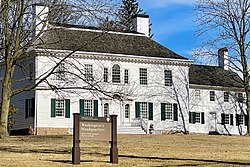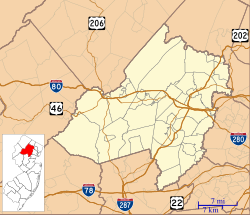United States historic place
| Morristown National Historical Park | |
| U.S. National Register of Historic Places | |
| U.S. National Historical Park | |
| New Jersey Register of Historic Places | |
 Ford Mansion, Washington's headquarters in Morristown, New Jersey Ford Mansion, Washington's headquarters in Morristown, New Jersey | |
   | |
| Location | In and around Morristown, New Jersey |
|---|---|
| Coordinates | 40°47′47″N 74°28′0″W / 40.79639°N 74.46667°W / 40.79639; -74.46667 |
| Area | 1,711 acres (6.92 km) |
| Built | 1744 (1744) |
| Architectural style | Georgian, Cape Cod |
| NRHP reference No. | 66000053 |
| NJRHP No. | 3381 |
| Significant dates | |
| Added to NRHP | October 15, 1966 |
| Designated NHP | March 2, 1933 |
| Designated NJRHP | May 27, 1971 |
Morristown National Historical Park is a United States National Historical Park, headquartered in Morristown, New Jersey, consisting of four sites important during the American Revolutionary War: Jockey Hollow, Ford Mansion, Fort Nonsense, and Washington's Headquarters Museum.
The sites are located in Morristown and Harding Township, both in Morris County, and in Bernardsville in Somerset County.
With its establishment on March 2, 1933, Morristown became the country's first National Historical Park. On October 15, 1966, citing its significance in archeology, architecture, and military history, it was added to the National Register of Historic Places.
Sites

Jockey Hollow, a few miles south of Morristown, New Jersey along Route 202 in Harding Township, was the site of a Continental Army encampment. It was from here that the entire Pennsylvania contingent mutinied and later, 200 New Jersey soldiers attempted to emulate them.
Fort Nonsense occupied a high hilltop overlooking Morristown, and is believed to have been the site of a signal fire and earthworks.
Ford Mansion in Morristown was the site of the "hard winter" (December 1779 – May 1780) quarters of George Washington and the Continental Army. That winter remains the coldest on record for New Jersey. Theodosia Ford, widow of Jacob Ford Jr., and her four children shared their household with Washington, his staff, including Alexander Hamilton, their servants and sometimes their family members. Martha Washington traveled from Mount Vernon to Morristown to spend the winter with her husband.
Washington's Headquarters Museum, the adjacent museum is open to the public Wednesday thru Sunday from September–June and seven days a week from July- August from 9:30 AM to 5:00 PM. The museum has three exhibit rooms and a sales area. A video production, Morristown: Where America Survived (New Jersey Network, 2009) is shown. The Ford Mansion is shown only by guided tour, which begins in the museum.
The New Jersey Brigade Encampment Site is located south of Jockey Hollow in Bernardsville in Somerset County. It was the encampment for approximately 1,300 Continental Army soldiers over the 1779-1780 winter.
Park history
In April 1932, the National Park Service (NPS) published a report recommending that the site of the Continental Army's winter encampments in 1776-77 and 1779-80 become a Federal Historical Reserve; the report recommended including two sites, Jockey Hollow and the Ford Mansion.
In January 1933, a conference including NPS representatives, the U.S. Secretary of the Interior, and civic and business leaders from the Morris County area, drafted a bill supporting the creation of a national historical park, with "the rank and dignity equal to the scenic program in the West."
The bill for creating the Morristown National Historical Park was submitted to Congress in mid-January (H.R. 14302; S. 5469) and was supported by U.S. Secretary of the Interior Ray Lyman Wilbur, who called it "the most important park project before this department at the present time."
In March 1933, in the last days of Herbert Hoover's presidency, the 72nd Congress established Morristown as the country's first National Historical Park.
See also
References
- "National Register Information System – (#66000053)". National Register of Historic Places. National Park Service. November 2, 2013.
- "New Jersey and National Registers of Historic Places - Morris County" (PDF). New Jersey Department of Environmental Protection - Historic Preservation Office. December 20, 2022. p. 15.
- Torres-Reves, Ricardo (October 1978). "National Register of Historic Places Inventory/Nomination: Morristown National Historical Park". National Park Service. With accompanying 21 photos
- Flexner, James Thomas (April 1984). Washington: The Indispensable Man. p. 154. ISBN 9780451156433.
- ^ "Expansion of the National Park Service in the 1930s". Administrative History. National Park Service. March 14, 2000.
- Hosmer, Preservation Comes of Age, I: 516-21, and Interview of Verne E. Chatelain by Charles B. Hosmer, Jr., December 17, 1971 (Manuscript on file at Harpers Ferry Center)
External links
 Media related to Morristown National Historical Park at Wikimedia Commons
Media related to Morristown National Historical Park at Wikimedia Commons- National Park Service: Morristown National Historical Park
- NPS Museum Exhibit: Morristown
- NJ Skylands: Morristown National Historical Park
- StateParks: Morristown National Historical Park
- NY-NJTC: Morristown National Historical Park Trail Details and Info
| New Jersey in the American Revolution | |
|---|---|
| 1776 | |
| 1777 | |
| 1778 | |
| 1779 | |
| 1780 | |
| 1781 | |
| 1783 | |
| Other | |
| See also: Crossroads of the American Revolution National Heritage Area, Morristown National Historical Park, Washington Crossing State Park | |
| National Historical Parks of the United States | ||
|---|---|---|
|
 | |
- Morristown National Historical Park
- 1933 establishments in New Jersey
- American Revolutionary War museums in New Jersey
- American Revolutionary War sites
- Historic house museums in New Jersey
- Morristown, New Jersey
- Museums in Morristown, New Jersey
- National Historical Parks in New Jersey
- National historical parks of the United States
- National Register of Historic Places in Morris County, New Jersey
- National Register of Historic Places in Somerset County, New Jersey
- New Jersey Register of Historic Places
- Parks in Morris County, New Jersey
- Parks in New Jersey
- Parks on the National Register of Historic Places in New Jersey
- Protected areas established in 1933
- Presidency of Herbert Hoover